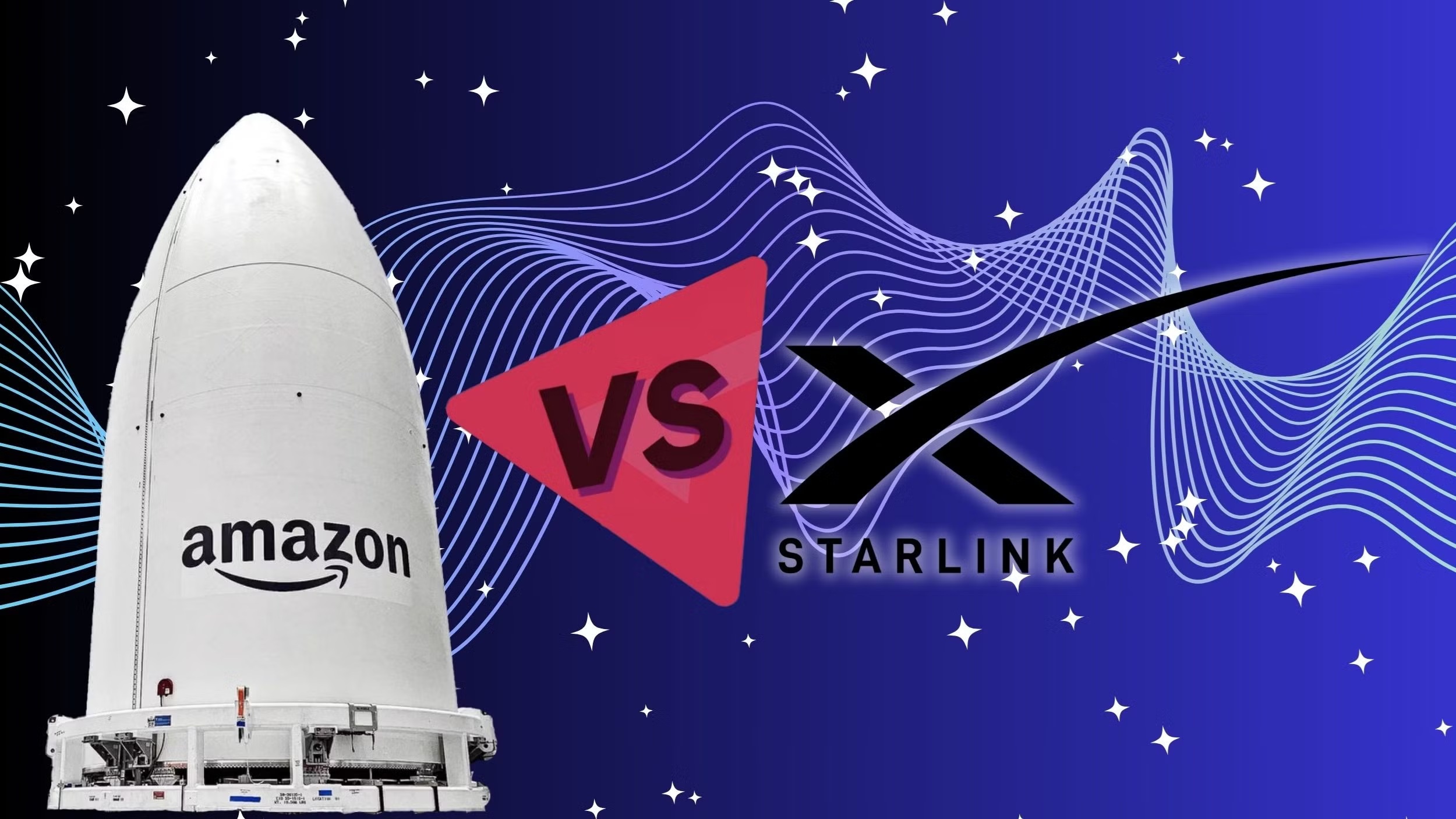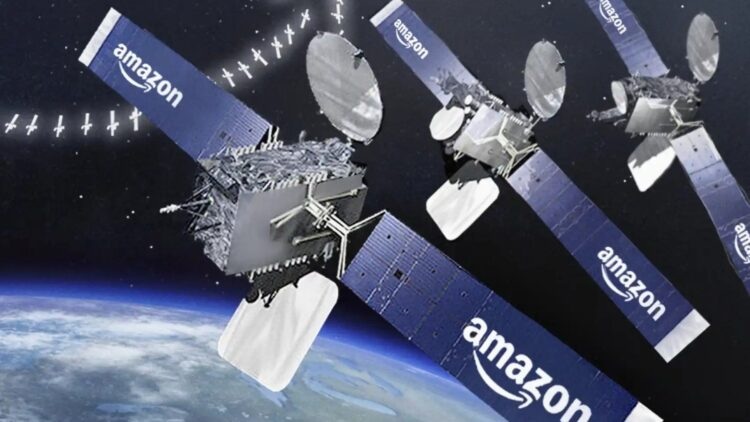Featured
Amazon’s Big Move Just Launched, Starlink Is In Trouble

Amazon has recently intensified its efforts to establish a dominant satellite internet service with the launch of additional Project Kuiper satellites, aiming to compete directly with SpaceX’s Starlink.
This report details the latest developments, technological ambitions, and strategic context of Amazon’s Project Kuiper initiative.
Overview of Project Kuiper
Project Kuiper is reportedly Amazon’s ambitious satellite internet initiative designed to provide high-speed and affordable broadband.
It is also designed to provide connectivity globally, with a particular focus on underserved rural and remote areas.
The project plans to deploy a constellation of 3,236 low Earth orbit (LEO) satellites, orbiting between approximately 590 and 630 kilometers above Earth.
It aims to deliver fast, low-latency internet service suitable for applications such as video calls, gaming, and HD streaming.
The initiative is backed by a $10 billion investment and has received approval from the U.S. Federal Communications Commission (FCC) to deploy and operate its satellite network.
Amazon’s approach integrates the satellite constellation:
- with compact customer terminals,
- a global network of ground stations, and,
- communications infrastructure powered by Amazon Web Services (AWS).
Recent Satellite Launches and Deployment Progress
Amazon has made significant strides in deploying its satellite constellation in 2025.
The first full-scale deployment occurred on April 28, 2025.
At this time, Amazon launched 27 Kuiper satellites aboard a United Launch Alliance (ULA) Atlas V rocket from Cape Canaveral Space Force Station in Florida.
This launch marked the beginning of Project Kuiper’s operational satellite network.

Amazon launch set to take out Starlink
On June 23, 2025, Amazon successfully launched a second batch of 27 Kuiper satellites, doubling its constellation to 54 satellites in orbit.
This launch, also conducted by ULA using an Atlas V rocket, was initially delayed due to weather and a booster engine issue.
However, it proceeded without incident on the rescheduled date.
These satellites join the initial 27 to form the foundation of the network.
Amazon plans to rapidly expand this constellation, with a goal to deploy at least half of the 3,236 satellites by July 2026, as required by the FCC.
To achieve this, Amazon has secured over 80 launch agreements with multiple providers.
These include ULA, Blue Origin, Arianespace, and even SpaceX, highlighting a broad and diversified launch strategy.
Competitive Context: Project Kuiper vs. Starlink
Project Kuiper is positioned as a direct competitor to SpaceX’s Starlink, which currently leads the satellite internet market with over 8,000 operational satellites.
Starlink reportedly began launching satellites in 2019 and has established a significant customer base.
On the other hand, Amazon aims to differentiate itself through technology, pricing, and integration with its AWS infrastructure.
Both services use LEO satellite constellations to provide broadband internet.
However, Amazon emphasizes affordability and a range of customer terminal options.
It ranges from ultra-compact models delivering up to 100 Mbps to enterprise-grade terminals capable of 1 Gbps speeds.
The competition is expected to benefit consumers by expanding satellite internet options and driving innovation.
Strategic and Technical Considerations
Launch and Manufacturing: Amazon operates a satellite production facility in Kirkland, Washington.
This is capable of producing up to five satellites per day, and a processing facility at Kennedy Space Center for integration with launch vehicles.
Space Safety and Sustainability: Project Kuiper prioritizes space safety and sustainability.
In this, it influences satellite design and operational protocols to minimize debris and interference with other space operators.
Global Connectivity Mission: The overarching goal is to close the global digital divide by providing reliable internet access to hundreds of millions of people lacking connectivity.
These include consumers, businesses, and government agencies.
Conclusion
Amazon’s recent deployment of additional Project Kuiper satellites marks a significant milestone in its quest to establish a competitive satellite internet service.
With 54 satellites now in orbit and ambitious plans for thousands more, Amazon is positioning itself as a major player in the space-based broadband market.
The project according to experts, intensifies competition with SpaceX’s Starlink.
According to them, it also promises to expand global internet access, particularly in underserved regions, leveraging Amazon’s technological and infrastructural strengths.
This ongoing satellite deployment and network expansion will be critical to watch as Amazon moves closer to offering commercial service expected to begin later in 2025.
The race to conquer internet connectivity from space is heating up, with Project Kuiper poised to play a pivotal role.

(DDM) – A disturbing case of alleged brutality by revenue enforcement agents in Anambra State has sparked outrage across the state and beyond.
Diaspora Digital Media (DDM) gathered that the deceased, identified as Mr. Okechukwu Theophilus Akaneme, a former chairman of the Onitsha Chamber of Commerce, reportedly suffered fatal injuries after being beaten by state revenue agents on October 11 last year.
Eyewitness accounts claim the assault stemmed from a dispute over unpaid waste management fees.
Family sources stated that Mr. Akaneme, who was reportedly in good health before the incident, sustained a severe spinal cord injury that left him paralyzed from the shoulders down.
Despite being rushed to the hospital and admitted into the intensive care unit, the businessman never fully recovered.
Medical expenses reportedly soared to ₦80 million, of which the Anambra State Government allegedly paid only ₦40 million, leaving the bereaved family with an outstanding debt of ₦40 million.
Critics say this tragic incident underscores what they describe as a culture of “revenue enforcement rascality” under Governor Chukwuma Soludo’s administration.
Business leaders argue that the practice of aggressive tax enforcement is driving fear among traders and investors in Anambra.
The video that went viral, obtained by DDM, named Mr. Joseph Okoye of Aswama as the alleged leader of the team that attacked Akaneme.
Police officers who reportedly accompanied the enforcement team have also been accused of complicity in the incident.
Sources close to the case say the Commissioner of Police in Anambra State has yet to make arrests, raising concerns about possible compromise or incompetence.
The victim’s family has called on the state government to take responsibility, prosecute those involved, and provide adequate compensation beyond partial hospital payments.
Human rights advocates have also joined the call for justice, warning that the impunity surrounding such incidents erodes public confidence in government institutions.
Critics argue that the value placed on human life under the current administration appears alarmingly low, citing similar complaints of excessive force by state task forces in the past.
Governor Soludo, a professor of economics and former Central Bank of Nigeria Governor, is facing mounting pressure to respond to allegations that his administration tolerates reckless enforcement practices.
Analysts say the incident could damage Anambra’s image as a safe and viable destination for investors.
Security and respect for human rights, they argue, are prerequisites for attracting major investments and fostering economic growth.
Political observers believe the government’s response to this case will be a major test of its commitment to justice, transparency, and the rule of law.
As public outrage grows, civil society groups, including the Coalition for the Protection of Democracy (COPDEM), are reportedly considering mass campaigns to demand accountability.
The late Mr. Akaneme has since been buried, but his family remains burdened by financial debt and grief.
Calls for justice continue to echo across Anambra, with residents asking how much value Governor Soludo places on the life of an ordinary citizen.
The police, the government, and all agencies involved are yet to issue a comprehensive statement addressing these allegations.
🚨 Follow DDM WhatsApp channel Now!
Get breaking news, hot gist, and updates FIRST!
*📲 Click to join 👇* https://whatsapp.com/channel/0029Vajkwdc4dTnFHl19vW3g
*Apply at the link below and Start Your Tech Journey:*
👇🏽
https://www.ddm.media/cohort-6

(DDM) – Governor Seyi Makinde of Oyo State has stressed that the Peoples Democratic Party (PDP) must be fully united before serious talks on its 2027 presidential candidate can begin.
Diaspora Digital Media (DDM) gathered that the call came during the PDP Southern Zoning Consultative Summit held in Ikeja, Lagos, where top party stakeholders convened to deliberate on internal reforms and a credible zoning formula ahead of the party’s national convention.
Makinde told reporters after the closed-door session that rebuilding trust, strengthening internal cohesion, and reconnecting with Nigerians must be the primary agenda before candidate selection.
He warned that rushing into zoning or candidate discussions without first addressing structural cracks within the party would doom the PDP to another electoral disaster.
The governor noted that critics who claim PDP is politically dead will be proven wrong as the party regains its organisational strength.
He insisted that the outcome of the Lagos meeting had already demonstrated the party’s willingness to put aside internal disputes for the sake of unity and national credibility.
Makinde emphasised that the summit was not statutory but necessary to engage stakeholders across all southern states in meaningful dialogue.
He added that democracy thrives on consultation, inclusivity, and respect for diverse voices within a party structure.
He said democracy should not be reduced to mere power grabs but should reflect credible engagement that represents the will of the people.
The Lagos summit was attended by prominent PDP leaders, including Governor Douye Diri of Bayelsa State, Governor Ademola Adeleke of Osun State, and representatives of Governor Peter Mbah of Enugu State.
Also present were former PDP Deputy National Chairman Chief Bode George, Board of Trustees Chairman Senator Adolphus Wabara, and several former governors including Olagunsoye Oyinlola, Udom Emmanuel, and Sam Egwu.
Makinde revealed that at least 12 of the 17 southern states were fully represented by zoning committee members, National Assembly representatives, and party elders.
The gathering also discussed the strategic role of the southern region in shaping the PDP’s chances in 2027, particularly given the intense political calculations expected around power rotation.
PDP’s history of zoning has been controversial, often sparking internal divisions over whether the presidency should rotate between the North and South.
In 2022, the party faced criticism after nominating Atiku Abubakar from the North despite calls for a southern candidate, a decision many analysts say fractured its support base in the 2023 elections.
This historical backdrop has heightened expectations ahead of the 2027 convention, with southern leaders pressing for early consultations to avoid past mistakes.
Makinde acknowledged that winning recent by-elections, particularly in Oyo State, had boosted PDP’s morale and disproved claims that the party was politically irrelevant.
He said the success reflected the resilience of PDP supporters and the commitment of its leaders to reclaim national dominance through hard work and strategic alliances.
The governor stressed that Nigerians are yearning for an alternative to the ruling All Progressives Congress (APC), adding that the PDP must present itself as a credible force.
He explained that Thursday’s meeting was part of a broader strategy to ensure the party’s zoning formula reflects fairness, justice, and national balance.
He also confirmed that more consultations will take place across southern states and eventually at the national level before the convention.
Political observers note that Thursday’s summit reflects growing pressure on the PDP to consolidate its base ahead of a highly competitive election season.
Analysts argue that the party’s ability to reconcile its factions and adopt an inclusive approach could determine its viability in 2027.
Makinde expressed confidence that the deliberations in Lagos would pave the way for further engagements capable of repositioning the party for victory.
He urged Nigerians to remain patient and optimistic as the PDP undertakes internal reforms to rebuild confidence in its leadership.
The meeting was called under the auspices of the PDP Zoning Committee, chaired by Governor Douye Diri, and was described as a success by attendees.
Stakeholders are expected to reconvene in the coming weeks for broader consultations and final recommendations before the party’s National Executive Council meeting.
Makinde closed by reiterating that zoning, candidate selection, and electoral strategy would only succeed if the PDP first restores unity, discipline, and credibility within its ranks.

(DDM) – The Nigerian Electoral Reform Coalition (NERCO) has undertaken an advocacy visit to the National Assembly (NASS) as part of its campaign for immediate electoral reforms.
Diaspora Digital Media (DDM) reports that the visit, held on Tuesday, marked the 20th day of the 30-day deadline NERCO had given lawmakers to initiate credible electoral reform.
According to NERCO representatives, the group had earlier delivered a letter to Senate President Godswill Akpabio and House Speaker Tajudeen Abbas on May 9, 2025, demanding urgent legislative action to overhaul the nation’s electoral system.
The coalition expressed disappointment over the lack of response from either chamber of the National Assembly.
NERCO stated that its advocacy involves Nigerians across faith-based, religious, and civic organizations who are committed to achieving a transparent and credible electoral process ahead of future elections.
The coalition emphasized that its demands are simple but critical to Nigeria’s democratic growth.
First, NERCO called for a credible process of appointing leadership at the Independent National Electoral Commission (INEC).
The group argued that only reputable and impartial individuals should oversee the commission, to avoid bias in election administration.
Second, NERCO demanded the full digitalization of the voting and result collation system.
The group stressed that accreditation, voting, and result display must be instantaneous and transparent, eliminating manual collation that has historically enabled electoral fraud.
NERCO insisted that these reforms are not “rocket science” and have been successfully implemented in other countries, adding that Nigeria must be ready to lead if necessary.
The coalition warned that failure to meet the 30-day deadline would prompt further actions, which it described as more intense than the current advocacy visit.
The group reaffirmed that its movement is self-funded and not driven by political sponsorship, describing it as a reflection of Nigerians’ collective frustration with flawed electoral processes.
COPDEM, the Coalition for the Protection of Democracy, also reacted to the visit, calling NERCO’s push “a timely reminder of Nigeria’s democratic responsibilities.”
COPDEM stated that the National Assembly must see electoral reform as an urgent priority, not a political bargaining tool, and called for immediate dialogue between legislators and civil society groups.
NERCO concluded by reiterating its demand that electoral reforms be passed within 2025, warning that delays would be unacceptable to Nigerians.

(DDM) – Vice President JD Vance’s visit to Union Station in Washington, DC, on Wednesday sparked a heated confrontation with demonstrators opposing the Trump administration’s security policies.
Diaspora Digital Media (DDM) gathered that Vance had arrived to host a lunch with National Guard members deployed by President Donald Trump. The troops were stationed across the capital following heightened security concerns. However, his remarks were frequently drowned out by chants from angry protesters.
Witnesses reported that Vance entered a Shake Shack restaurant at Union Station to a mix of applause and loud boos. Some patrons chanted “USA, USA, USA” in support of the vice president, while others responded with cries of “shame” and “we want the military out of our streets.”
The vice president, joined by Defense Secretary Pete Hegseth and White House deputy chief of staff Stephen Miller, greeted troops and thanked them for their service. But tensions escalated when protesters, blocked from the second floor where the officials were gathered, intensified their chants and disrupted a press gaggle with Vance.
Speaking to reporters, Vance dismissed the protesters as “crazy” and “communists,” accusing them of misrepresenting the city’s views on public safety. Miller went further, labelling demonstrators as “elderly white hippies” and claiming, without evidence, that they were “not part of the city.”
Vance defended the administration’s stance, recounting a previous visit to the station where he claimed his family encountered “violent vagrants” that left his children frightened. “People want safer streets, and we’re here to ensure that,” he said.
The Trump administration has faced sharp criticism for ordering the deployment of the National Guard and FBI to patrol Washington, DC, and for attempts to assume control of the city’s police department. A Washington Post-Schar School poll shows that roughly eight in ten DC residents oppose these measures, reflecting deep tensions between federal authorities and local voters.
Despite the backlash, Vance insisted he was “highly skeptical that a majority of DC residents don’t want their city to have better public safety and more reasonable safety standards.”
The visit underscored a stark political divide. While some cheered the administration’s commitment to law and order, others saw the presence of troops as a provocative overreach into a city that overwhelmingly voted against Trump.
Outside the Shake Shack, protesters continued to chant as Vance departed, leaving the debate over federal control of DC policing far from resolved.

(DDM) – The Coalition for the Protection of Democracy (COPDEM) has condemned the Nigerian government following the embarrassing sight of an empty national pavilion at the International Investment Fair in Japan.
Diaspora Digital Media (DDM) gathered that the fair, which commenced on August 18, 2025, drew global investors, trade experts, and economic leaders to explore opportunities across various countries.
However, Nigeria, Africa’s largest economy was shockingly unrepresented at its own stand, despite President Bola Ahmed Tinubu and a large delegation of officials reportedly attending the event.
A viral video from the fair showed vibrant stands from Cameroon, Senegal, Togo, Sierra Leone, and Guinea, each managed by representatives showcasing their nations’ economic potential.
In stark contrast, Nigeria’s booth stood deserted, with no official present to welcome prospective investors or provide promotional materials.
COPDEM, in a strongly worded statement, described the situation as “an international disgrace and a symbol of Nigeria’s collapsing governance culture.”
The group stated that the incident highlighted a disturbing trend where public funds are spent on lavish foreign trips, yet critical tasks like economic representation are neglected.
“The President cannot lead a horde of officials to a global investment fair only for Nigeria’s stand to be empty,” COPDEM declared.
“This is more than incompetence; it is a clear sign that the welfare of the country is secondary to political pageantry.”
The International Investment Fair, hosted annually in Tokyo, Japan, provides a platform for countries to present business opportunities, forge trade partnerships, and attract foreign direct investment.
Analysts say Nigeria’s absence at its own pavilion represents a costly missed opportunity, especially as the nation battles economic instability and declining investor confidence.
COPDEM further called for an immediate probe into the delegation’s activities in Japan and demanded a public explanation from the Ministry of Trade, Investment and Industry.
The group warned that such blunders could further damage Nigeria’s international image and reinforce perceptions of mismanagement at the highest levels.
Meanwhile, social media users flooded platforms with critical comments, describing the incident as “a national embarrassment” and questioning how much was spent on the trip.
The fair continues until August 22, 2025, but critics say the damage to Nigeria’s reputation has already been done.
-

 Featured4 days ago
Featured4 days agoYour Attacks on Peter Obi Are Petty, Stop It! Chekwas Rebukes Soludo
-

 News4 days ago
News4 days agoTension in Anambra community as senior police officer shoots kinsman dead
Colleagues, others try cover-up; victim's family fights back
-

 News7 days ago
News7 days agoAnambra South Bye-Election: APC Chief Rescues Deputy Gov Caught In Vote Buying From Angry Youths
By Chuks Collins, Awka
-

 News5 days ago
News5 days agoNigerian visa applicants must provide 5-yr social media history — US embassy
-

 Celebrity/Entertainment23 hours ago
Celebrity/Entertainment23 hours agoHow Nigerian TikToker Geh Geh Made ₦45 Million in One Night
-

 Analysis6 days ago
Analysis6 days agoSystemic Sabotage: How APC, INEC Colluded To Undermine Amamgbo’s Senatorial Bid
By Arthur Ezechukwu
-

 News3 days ago
News3 days agoTerrorist Organisation: APC, PDP Members in US, UK, France Risk Deportation
-

 Celebrity/Entertainment5 days ago
Celebrity/Entertainment5 days agoWhy single mothers can’t raise boys into proper men — Jim Iyke
-

 News7 days ago
News7 days agoBREAKING: Troops arrest Nigeria’s most wanted terror kingpin
-

 News2 days ago
News2 days agoVandal electrocuted while vandalizing Aba power infrastructure












